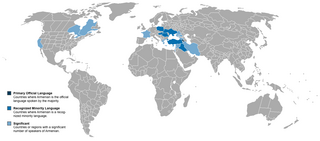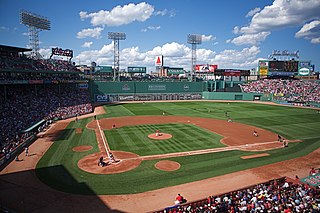History
It was founded by Stepan Sapah-Gulian in 1903. The first issue was published in only 250 examples. "Yeritasard Hayastan" was edited by G. Yeghikyan, B. Varaztahd, H. Tyurabyan, Arsen Jerejian and others. It published news from Armenia and Armenian diaspora and analytical articles on social and political issues, including the Armenian Question, which was one of the main topics of publications. Yeritasard Hayastan was a weekly until 1973, then became a monthly publication edited by Arsen Jerejian (until 1997). [1]
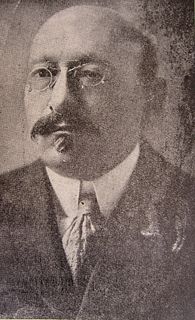
Stepan Sapah-Gulian was a prominent Armenian journalist, political scientist, intellectual and a leader of the Social Democrat Hunchakian Party.

The Armenian diaspora refers to the communities of Armenians outside Armenia and other locations where Armenians are considered an indigenous population. Since antiquity, Armenians have established communities in many regions throughout the world. However, the modern Armenian diaspora was largely formed as a result of the Armenian Genocide of 1915, when the Armenians living in their ancestral homeland in eastern Turkey, known as Western Armenia to Armenians, were systematically exterminated by the Ottoman government.
The term "Armenian Question", as used in European history, became commonplace among diplomatic circles and in the popular press after the Congress of Berlin in 1878. As with the Eastern Question, it refers to Europe's involvement with the Armenian subjects of the Ottoman Empire, beginning with the Russo-Turkish War of 1877–78. In specific terms, the Armenian question refers to the protection and the freedoms of Armenians from their neighboring communities. The "Armenian Question" explains the 40 years of Armenian-Ottoman history in the context of English, German, and Russian politics between 1877–1914. The term "Armenian Question" is also often used to refer to the question of Turkey's lack of acknowledgement of the events surrounding the Armenian Genocide. Armenian Question is also a high school subject in some schools of Armenia.
In October 1998, Yeritasard Hayastan moved to Yerevan, and poet Manuel Adamian was the editor. [2] Then, from 1999 to October 2003, it was published by the Armenian Social Democrat Hunchakian Party (editors - Armine Sargsyan, Serj Melkumyan), separated from the main SDHP and its Armenian branch. Each issue contained 8 pages.
This page is based on this
Wikipedia article Text is available under the
CC BY-SA 4.0 license; additional terms may apply.
Images, videos and audio are available under their respective licenses.
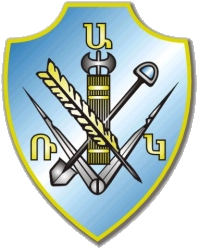
The Armenian Democratic Liberal Party, the Ramgavar Party,, also known by its Armenian initials or its English initials ADL is an Armenian political party in the Armenian diaspora including the Middle East, Europe, the Americas and Australia.

Ararad is a daily Lebanese Armenian newspaper and the official organ of the Armenian Social Democrat Hunchakian Party (Henchak) in Lebanon. It is a four-page daily. Its executive director is Ani Yepremian since September 2012.
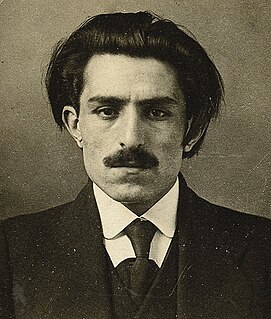
Vahan Terian was an Armenian poet, lyrist and public activist. He is known for his sorrowful, romantic poems, the most famous of which are still read and sung in their musical versions.
The Zeitun rebellion or Second Zeitun Resistance took place in the winter of 1895–1896, during the Hamidian massacres, when the Armenians of Zeitun, fearing the prospect of massacre, took up arms to defend themselves from Ottoman troops.

Hampartsum Boyajian, also known by his noms de guerre Murad and sometimes Medzn Murad, was an Armenians fedayi and a leading political activist of the Hunchak party.
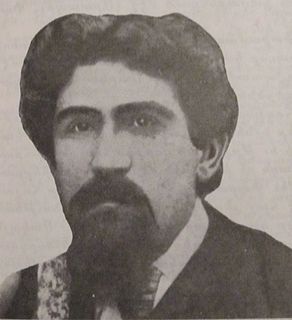
Paramaz, born Matteos Sarkissian, was an Armenian fedayee, freedom fighter, writer and political activist.
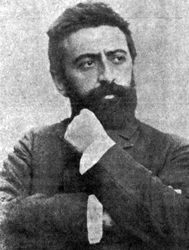
Arpiar Arpiarian was an influential 19th-century Armenian writer, the pioneer of realism in Armenian literature and a political activist.
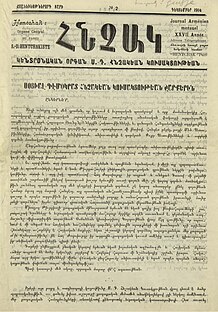
Hunchak was the official organ of the Social Democrat Hunchakian Party.

Girayr, or Zhirair, born Harutiun-Mardiros Boyadjian was an Armenian fedayee leader, the senior brother of Medzn Mourad.
Ruben Khan-Azat, was an Armenian political activist, one of the founders and leaders of the Social Democrat Hunchakian Party and Hunchak journal.
Gabriel Gerasimi Kafian was an Armenian political and public activist, one of the founders of Social Democrat Hunchakian Party.

Tchahagir is an Armenian-language bi-weekly published in Cairo, Egypt, by the Social Democrat Hunchakian Party.
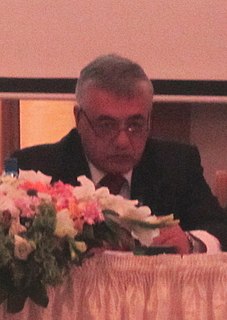
Yeghia (Yeghig) Jerejian is a Lebanese-Armenian author and political figure, Social Democrat Hunchakian Party Central Committee Member. From 1992 to 2009 he was elected as a member of the Lebanese parliament from Beirut.

Aram Achekbashian was an Armenian politician who became a member of Social-Democrat Hunchakian Party Central Committee in 1903.

Kegham Vanigian, also known as "Vanig," was an Armenian political activist and newspaper editor. Vanigian is best remembered as the founder of the socialist monthly Gaidz of the Hnchak party. Vanigian was executed by the Turkish government for his political activities in 1915 during the Armenian Genocide.

Sarkis Dkhrouni was an Armenian political figure and editor. Armenian Dkhrouhi Youth Association is named after him.
Hayastan was an Armenian public and political daily published from April 1917 to February 1918 in Tbilisi (Tiflis) by General Andranik.
Hayastan is the Armenian name for Armenia, a country in the South Caucasus region of Eurasia.

